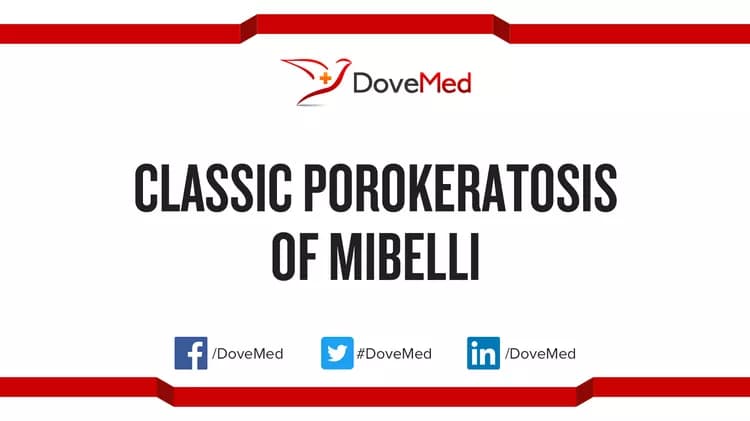What are the other Names for this Condition? (Also known as/Synonyms)
- Classic Mibelli Porokeratosis
- Plaque-type Porokeratosis
- PM (Classic Porokeratosis of Mibelli)
What is Classic Porokeratosis of Mibelli? (Definition/Background Information)
- Classic Porokeratosis of Mibelli (or PM) is the second most common subtype of porokeratosis, an uncommon skin condition that results in the manifestation of small patches of lesions of varying sizes on skin
- Classic Porokeratosis of Mibelli is generally seen during childhood and young adulthood. The specific predisposing factors for the condition may include light therapy and long-term steroid use
- The cause of development of Classic Porokeratosis of Mibelli is not identified yet. It may be due to certain genetic mutations that are yet to be well-characterised
- The onset of the condition takes place as small raised skin lesions that may later increase in size and numbers. Any part of the body may be affected, but many are observed on the arms and legs
- A diagnosis of Classic Mibelli Porokeratosis is made by studying the presenting symptoms and skin biopsy (microscopic examination of the skin lesions). Following its diagnosis, the condition may be treated using topical creams and gels, oral medications, and laser therapy
- In general, the prognosis of Classic Porokeratosis of Mibelli is good with appropriate treatment, since it is mostly benign. Nevertheless, a few cases are known to be associated with skin cancers
Who gets Classic Porokeratosis of Mibelli? (Age and Sex Distribution)
- Classic Porokeratosis of Mibelli may occur at any age, although most cases are observed in children and young adults
- Both males and females may be affected; though, a male predominance is observed (male-female ratio is 2:1)
- Individuals of all racial and ethnic background can be affected
What are the Risk Factors for Classic Porokeratosis of Mibelli? (Predisposing Factors)
The risk factors for Classic Porokeratosis of Mibelli may include:
- Phototherapy or light therapy
- Radiation therapy
- Topical long-term steroid use
The risk factors for porokeratosis, in general, may include:
- Individuals with light skin are more prone to porokeratosis than dark-skinned individuals
- Some subtypes of porokeratosis are known to run in families, which may indicate a genetic linkage
- Exposure to ultraviolet radiation
- Weakened immune system
- Chemotherapy
- Skin trauma
- Skin infections; hepatitis C infection
- Skin burns
- Chronic liver failure
- Presence of certain autoimmune disorders such as rheumatoid arthritis (RA) and psoriasis
- Poorly-controlled diabetes
- Long-term systemic and topical steroid therapy
It is important to note that having a risk factor does not mean that one will get the condition. A risk factor increases one’s chances of getting a condition compared to an individual without the risk factors. Some risk factors are more important than others.
Also, not having a risk factor does not mean that an individual will not get the condition. It is always important to discuss the effect of risk factors with your healthcare provider.
What are the Causes of Classic Porokeratosis of Mibelli? (Etiology)
The exact cause of development of Classic Porokeratosis of Mibelli is unknown.
- In general, porokeratosis may be due to certain genetic factors. Presently, the specific genes causing the skin condition are under study
- It is important to note that Classic Mibelli Porokeratosis is non-contagious and it cannot be transmitted from one individual to another
What are the Signs and Symptoms of Classic Porokeratosis of Mibelli?
The signs and symptoms of Classic Porokeratosis of Mibelli include:
- Skin lesions that occur in small patches on the body
- They usually start as small bumps, which may be slightly raised
- These bumps may become larger to form plaque-like lesions and grow in numbers
- The skin may become atrophic (skin breaks and bleed), due to the lesions
- These cutaneous lesions can occur anywhere in the body; the usual sites are the upper and lower limbs
How is Classic Porokeratosis of Mibelli Diagnosed?
A diagnosis of Classic Porokeratosis of Mibelli may involve the following:
- A thorough medical history assessment and complete physical examination
- Dermoscopy: It is a diagnostic tool where a dermatologist examines the skin using a special magnified lens
- Wood’s lamp examination: In this procedure, the healthcare provider examines the skin using ultraviolet light. It is performed to examine the change in skin pigmentation
- Blood test to diagnose underlying autoimmune disorders, if any
- Culture studies to rule out any infection
- Skin biopsy: A skin biopsy is performed and sent to a laboratory for a pathological examination. The pathologist examines the biopsy under a microscope. After putting together clinical findings, special studies on tissues (if needed) and with microscope findings, the pathologist arrives at a definitive diagnosis. On examination of the specimen, certain characteristic features may be noted
Many clinical conditions may have similar signs and symptoms. Your healthcare provider may perform additional tests to rule out other clinical conditions to arrive at a definitive diagnosis.
What are the possible Complications of Classic Porokeratosis of Mibelli?
In many cases, Classic Porokeratosis of Mibelli is a benign condition, and it does not cause any significant complications. However, the following factors may be a cause for concern in some individuals:
- The presence of large patches of skin lesions may result in cosmetic issues (especially when it involves the face or exposed skin areas)
- This may result in emotional stress
- In some individuals more than one subtype of porokeratosis is observed
- Rarely, skin cancers are known to develop at these sites
How is Classic Porokeratosis of Mibelli Treated?
There is currently no definitive cure for Classic Porokeratosis of Mibelli (PM). However, the condition may require no treatment, if the symptoms are mild. In such cases, regular observation/monitor by the healthcare provider may be sufficient treatment. However, in case they are at a body site that causes discomfort and/or present significant cosmetic worries in the individual, they may be treated accordingly.
The treatment adopted for Classic Mibelli Porokeratosis includes the use of the following measures:
- Topical 5-fluorouracil medication therapy
- Oral isotretinoin
- Cryotherapy
- Dermabrasion
- Laser therapy
- If the cause of PM is underlying autoimmune disorder, then treatment for the same is necessary
Follow-up care with regular screening and check-ups are important and encouraged.
Note: Any medications containing isotretinoin, which is a known teratogenic agent (having the potential to cause fetal defects), should be avoided during pregnancy.
How can Classic Porokeratosis of Mibelli be Prevented?
Currently, there are no known methods to prevent the occurrence of Classic Porokeratosis of Mibelli. However, protecting oneself from the harmful ultraviolet rays of sun through the following measures may avoid aggravation of the condition:
- Use sunscreens with high sun-protection factor, wide brimmed hats, and protective clothing
- Be aware of the hazards of prolonged sun exposure and take steps to protect yourself
- Individuals, who are regularly exposed to the sun, or work under the sun should get their skin periodically examined by a physician
- Avoid excessive sunbathing
What is the Prognosis of Classic Porokeratosis of Mibelli? (Outcomes/Resolutions)
- The prognosis for Classic Porokeratosis of Mibelli is usually good, in a majority of cases, since it is a benign condition that may only present some cosmetic issues. Even if treatment is provided, it may not get better in many individuals
- However, in some cases, it may be associated with malignancy, and hence close clinical monitoring is necessary
Additional and Relevant Useful Information for Classic Porokeratosis of Mibelli:
- Do not pick or pop the blisters, for doing so can affect the healing process and may result in secondary infections
- Cleaning the skin too hard with strong chemicals or soaps may aggravate the skin condition. Care must be taken avoid strong soaps and chemicals that could potentially worsen the condition
- The presence of dirt on the body is not a causative factor for the condition. However, it helps to be clean and hygienic, which may help the condition from getting worse
Related Articles
Test Your Knowledge
Asked by users
Related Centers
Related Specialties
Related Physicians
Related Procedures
Related Resources
Join DoveHubs
and connect with fellow professionals



0 Comments
Please log in to post a comment.